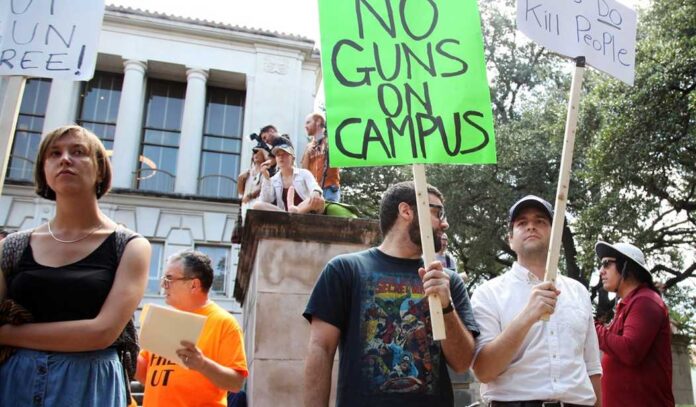The University of Michigan in Ann Arbor is a sprawling campus that covers more than 3,200 acres of the town, and each and every inch is considered a “sensitive place” where lawful concealed carry is prohibited. Thanks to the Michigan Supreme Court, the massive “gun-free zone” will remain intact for the foreseeable future, after the justices turned away an appeal of a lower court decision upholding the ban.
“The efficacy of gun bans as a public safety measure is a matter of debate,” the appeals court said. “However, because the university is a school, and thus a sensitive place, it is up to the policy-maker — the university in this case — to determine how to address that public safety concern.”
The Michigan Supreme Court’s most conservative members, justices David Viviano and Brian Zahra, wanted to take the case. They said the appeals court wrongly analyzed it, leaving a “near total ban of firearms on a large section of Ann Arbor.”
This appears to be yet another case of courts misreading what the Supreme Court said in Bruen. As Viviano and Zahra wrote in their dissent, while the Supreme Court did include “schools” in its short list of locations that have historically been seen as “sensitive places”, the Court also rejected the idea that governments could declare wide swaths of property (like the island of Manhattan) a “sensitive place.”
Yet the Court of Appeals tried to take a shortcut here. As can be seen from its multifactor test, the Court suggested that any historical analysis is unnecessary if a location is a sensitive place. This completely ignores that sensitive places are those locations with historical regulations. And in applying its newly fabricated test, the Court once again offered little more than an analysis of whether universities are schools, this time relying solely on modern definitions of schools…. As I noted before, my own review of historical gun restrictions on campuses and the secondary literature on the topic has not uncovered any tradition of complete firearm bans, only partial and targeted prohibitions, e.g., regulations on the discharge of firearms on campus.
It seems doubtful that after establishing a text-and-tradition approach to the Second Amendment, the Supreme Court would uphold total bans on firearms in locations that historically never had such prohibitions. Indeed, such a regulation would not be supported by text or tradition, so what reasoning could support it? A rationale grounded in the pragmatic balancing of interests was rejected in Bruen, as discussed above. I therefore struggle to see how the Court of Appeals’ framework here, which eschews text and tradition altogether, can be justified under the Supreme Court’s precedent.
It’s not like the University of Michigan is a self-enclosed campus located on the outskirts of town. It sits in the heart of Ann Arbor, and it’s incredibly easy to inadvertently walk onto campus without realizing it. It’s absurd to think that all 3,207 acres of the campus are “sensitive” locations, but to make matters worse, Viviano and Zahra say the appellate court intentionally rejected the Supreme Court’s test laid out in Bruen in favor of their own.
According to the Supreme Court, if a particular statute is being challenged, it’s up to the courts to first determine whether the law implicates the Second Amendment. If it does (as is the case with the university’s carry ban), then it’s up to the state to prove that the regulation fits within the text, history, and tradition of right to keep and bear arms. Instead of doing that, the appellate court came up with a bizarre four-part test that just assumes some “sensitive places” can’t be challenged.
1) Courts must first consider whether the Second Amendment presumptively protects the conduct at issue. If not, the inquiry ends and the regulation does not violate the Second Amendment.
2) If the conduct at issue is presumptively protected, courts must then consider whether the regulation at issue involves a traditional “sensitive place.” If so, then it is settled that a prohibition on arms carrying is consistent with the Second Amendment.
3) If the regulation does not involve a traditional “sensitive place,” courts can use historical analogies to determine whether the regulation prohibits the carry of firearms in a new and analogous “sensitive place.” If the regulation involves a new “sensitive place,” then the regulation does not violate the Second Amendment.
4) If the regulation does not involve a sensitive place, then courts must consider whether the government has demonstrated that the regulation is consistent with this Nation’s historical tradition of firearms regulations. This inquiry will often involve reasoning by analogy to consider whether regulations are relevantly similar under the Second Amendment. If the case involves “unprecedented societal concerns or dramatic technological changes,” then a “more nuanced approach” may be required.
As the dissenting justices point out, the appellate court’s second step is nowhere to be found in Supreme Court precedent or dicta. Even in those locations like schools or government buildings, it’s still up to the defendants to show that the carry ban comports with history and tradition, and there’s not much evidence that the entirety of a modern university that stretches across 1/10th of a city could be rightfully considered a “sensitive place.” There may very well be specific locations on campus that would fit within that framework, but the total prohibition on lawful carry goes too far.
Now that the state Supreme Court has turned away the challenge, there is an opportunity to move the case to federal court, but that will be a lengthy and expensive process. For now, anyway, the UofM carry ban remains in effect, and concealed carry holders in Ann Arbor need to watch where they step lest they unwittingly and unknowingly violate the law.




